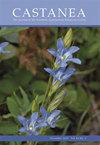Plant and Arthropod Community Responses to Fire in a Glade-Forest Landscape Matrix
IF 0.3
4区 生物学
Q4 PLANT SCIENCES
引用次数: 0
Abstract
ABSTRACT Fragmented landscapes are a mosaic of ecosystems containing diverse communities of plants and herbivorous arthropods. Plant responses to fire in fire-prone ecosystems are well documented, but less is known about how plant-herbivorous arthropod interactions respond to fires. This study compared the responses of plant communities and their interactions with herbivorous arthropods to fire in a highly fragmented fire-prone glade system. Due to the mosaic landscape of the study site, three habitat types were chosen to delineate communities based on plant species composition, geology, and proximity to each other: small enclosed glade, large open glade, mixed hardwood forest, and pine savanna. From 2016–2019, we observed the interspecific interactions between plant and arthropod communities in the Ketona dolomitic glades of Bibb County in central Alabama. We identified plants to genus or species and recorded evidence of herbivory by seven herbivore guilds of arthropods. We used non-Metric Multidimensional Scaling and Analysis of Similarity to determine patterns of change between the habitats and across years for both plant species and interactions with herbivorous arthropods. Plant communities return to pre-burn species diversity within two years. Plant community composition was grouped strongly by habitat type and year, while interactions with herbivorous arthropods were homogenous across habitats but grouped strongly by year. Tracking herbivorous arthropod guilds using plant association evidence is useful for rapidly and temporally determining overall responses in herbivorous arthropod guild composition. However, it is too coarse to determine changes and responses in herbivorous arthropod guild composition at finer spatial scales.Glade森林景观基质中植物和节肢动物群落对火灾的响应
摘要碎片景观是一个由植物和草食性节肢动物组成的生态系统马赛克。在易发生火灾的生态系统中,植物对火灾的反应有充分的记录,但对植物-草食性节肢动物的相互作用如何对火灾做出反应知之甚少。这项研究比较了在高度分散的易发生火灾的空地系统中,植物群落及其与草食性节肢动物的相互作用对火灾的反应。由于研究地点的马赛克景观,根据植物物种组成、地质和相互接近程度,选择了三种栖息地类型来划定群落:小型封闭林地、大型开放林地、混合硬木林和松树稀树草原。从2016年到2019年,我们在阿拉巴马州中部比布县的Ketona白云石林中观察了植物和节肢动物群落之间的种间相互作用。我们确定了植物的属或种,并记录了七个节肢动物草食性群落的草食性证据。我们使用非度量多维标度和相似性分析来确定栖息地之间以及植物物种与草食性节肢动物相互作用的多年变化模式。植物群落在两年内恢复到燃烧前的物种多样性。植物群落组成按栖息地类型和年份划分,而与草食性节肢动物的相互作用在不同栖息地是同质的,但按年份划分。利用植物关联证据追踪草食性节肢动物群落有助于快速、暂时地确定草食性食肉动物群落组成的整体反应。然而,它过于粗糙,无法在更精细的空间尺度上确定草食性节肢动物群落组成的变化和反应。
本文章由计算机程序翻译,如有差异,请以英文原文为准。
求助全文
约1分钟内获得全文
求助全文
来源期刊

Castanea
生物-植物科学
CiteScore
0.50
自引率
25.00%
发文量
28
审稿时长
>12 weeks
期刊介绍:
Castanea is named in honor of the American Chestnut tree. Castanea is thebotanical name for Chestnuts, dating back to what the ancient Greeks calledthem.
The American Chestnut is a critically endangered tree that once made up 35%of the forests of the Eastern US before being devastated by a blight thatdestroyed up to 4 billion American Chestnut trees.
Castanea serves professional and amateur botanists by reviewing andpublishing scientific papers related to botany in the Eastern United States.
We accept papers relating to plant biology, biochemistry, ecology, floristics,physiology and systematics.
 求助内容:
求助内容: 应助结果提醒方式:
应助结果提醒方式:


